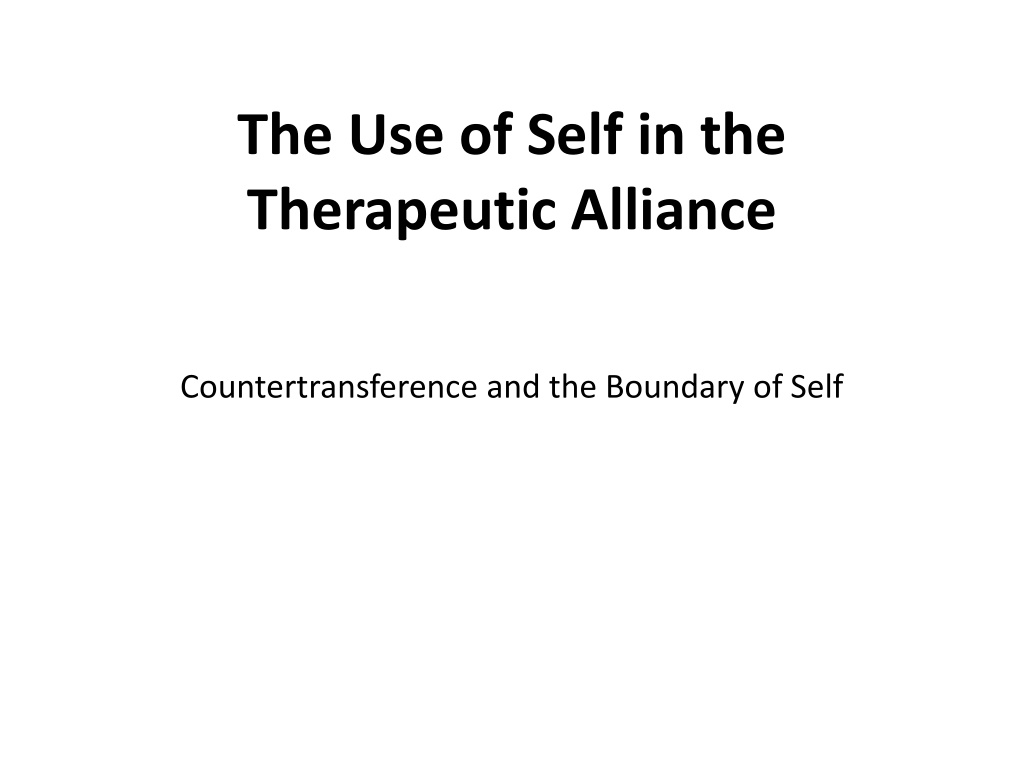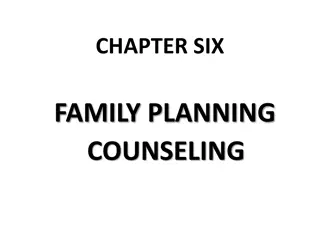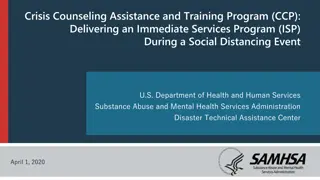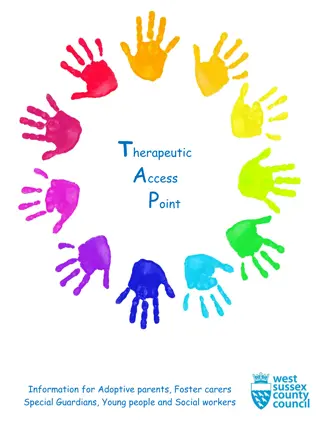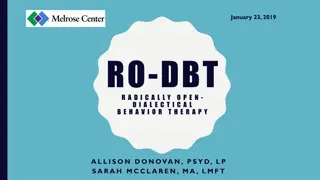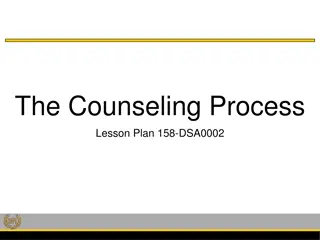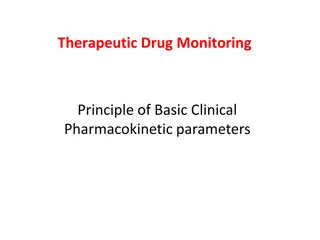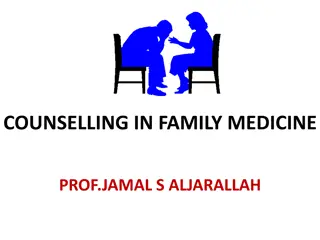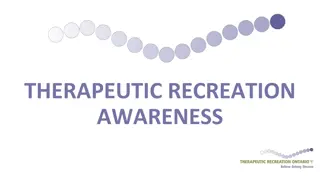Understanding Therapeutic Values and Dynamics in Counseling
Exploring the essential elements in counseling such as the use of self in the therapeutic alliance, countertransference, recognizing counselor values, and psychological transference. Learn how to navigate biases, cultural norms, and client dynamics to establish effective therapy relationships.
Download Presentation

Please find below an Image/Link to download the presentation.
The content on the website is provided AS IS for your information and personal use only. It may not be sold, licensed, or shared on other websites without obtaining consent from the author. Download presentation by click this link. If you encounter any issues during the download, it is possible that the publisher has removed the file from their server.
E N D
Presentation Transcript
The Use of Self in the Therapeutic Alliance Countertransference and the Boundary of Self
To be a proficient counselor It is not sufficient to be merely a good person with good intentions.
The Counselors Values Recognize that you are not value-neutral Be aware of value imposition How your values influence your interventions How your values may influence your client s experiences in therapy
The Counselors Values Your job is to assist clients in finding answers that are most congruent with their own values Find ways to manage value conflicts between you and your clients Begin therapy by exploring the client s goals
The Counselors Values Become aware of your biases and values Become aware of your own cultural norms and expectations Attempt to understand the world from your client s vantage point Gain a knowledge of the dynamics of oppression, racism, discrimination, and stereotyping
The Counselors Values Study the historical background, traditions, and values of your client Be open to learning from your client Challenge yourself to expand your vantage point to explore your client s ways of life that are different from your own Develop an awareness of acculturation strategies
Psychological Transference The client reacts to the therapist as he did to an earlier significant other - This allows the client to experience feelings that would otherwise be inaccessible ANALYSIS OF TRANSFERENCE allows the client (or clinician) to achieve insight into the influence of the past
Self Awareness All Counselors should know what triggers them, and what are their areas of vulnerability and conflict.
Empathy vs. Sympathy Clinically productive empathy is an emotional understanding of the impact of a person s experiences that informs and deepens an objectively engaged relationship to the person at the time of the encounter. Clinically unproductive sympathy is an emotional co-ownership of the person s distress state. It obscures boundaries and undermines the clinician s effectiveness.
Structural Model of Countertransference Therapist s areas of unresolved conflict that give rise to countertransference: How to measure? 1. Self-report: relies on therapist s ability and willingness to respond accurately (e.g., to measures, interview questions) 2. Discrepancies between self-report and peer report: blind spots (e.g., Cutler, 1958; Rosenberger & Hayes, 2002) 3. Projective tests: Core Conflictual Relationship Theme (needs, wishes, responses from others) 4. Reaction times to potentially conflict-relevant words
Structural Model of Countertransference Triggers: factors that evoke or stimulate therapist s unresolved conflicts, such as client appearance, what client says or does, changes in structure of therapy. Origins + Triggers = Causes: How to measure? 1. Audiotapes or videotapes of client actors (laboratory research) 2. Themes in what client talks about (field research) 3. Client non-verbal behavior (Penman, SASB)
Structural Model of Countertransference Manifests as therapist reactions when unresolved issues are provoked: How to measure? 1. Behavioral: avoidance; over-involvement; Inventory of Countertransference Behavior (trained raters, supervisors) 2. Cognitive: inaccurate recall of client material 3. Emotional: anxiety; Therapist Appraisal Questionnaire (self-report) 4. Visceral: anxiety (galvanic skin response)
Structural Model of Countertransference Management involves the therapist s strategies for coping with countertransference manifestations: How to measure? 1. Supervisor ratings of extent to which trainee possesses factors that enhance countertransference management 2. Self-reported in-session coping mechanisms (Management Strategies List)
Patterns of Transference & Countertransference According to the Structuralist model, there are 17 basic patterns or manifestations of Countertransference. They are: 1. Needy 2. Need-denying 3. Insecure 4. Isolated 5. Compliant
Patterns of Transference & Countertransference 6. Defiant 7. Passive-aggressive 8. Controlling 9. Victim 10. Co-dependent 11. Suspicious 12. Aggressive
Patterns of Transference & Countertransference 13. Self-judging 14. Charming 15. Brittle 16. Prideful 17. Entitled
Vicarious traumatization (VT) Secondary post traumatic stress reaction Secondary traumatic stress Secondary traumatic stress disorder Compassion fatigue Compassion stress Soul sadness Empathic strain Contact victimization It s not a matter of If , it s a matter of When
Signs and symptoms of VT Feeling frustration or anger about a patient s choices Thinking about a patient outside of work more than you want to Feeling anxious about working with a patient Feeling dread when you anticipate seeing a patient Feeling more worried than you think is necessary about a patient Feeling angry at a patient Feeling de-skilled or incompetent when you meet with a patient Taking on too much responsibility-difficulty leaving work at end of day stepping in to control other s lives
Signs and symptoms of VT Feeling disconnected or dissociated from the patient, their emotions or the content of the session Having physical discomfort or pain while meeting with a patient, which seems connected with what you re working on Having other physical reactions to a patient s stories, e.g. increased heart rate, rapid or shallow breathing, nausea, feeling frozen etc. Feeling traumatized after talking with a patient about specifics of their abuse Wanting to cry during/after meeting with a patient Feeling helpless about your work with a patient Feeling enraged at a patient s perpetrators
Prevention An effective action plan for addressing vicarious trauma using self care will reflect your own needs, experiences, interests, resources, culture, and values. Escape get away from work/trauma material Rest do things you find relaxing Play physical activity, creativity, laugh
Tools for transforming damage from VT Awareness Being attuned to own needs, limits, emotions, reactions, resources. Mindfulness and acceptance. Keep mind and body in same place. Balance Professional and personal rest/work/play. i.e. Eat lunch/go home at end of shift. Spend time laughing with friends Connection To oneself, others, something larger. Decreases isolation, increases validation and hope. An essential part of spiritual connection is to find one s own path to connecting with a sense of awe, joy, purpose, meaning, and hope and visiting it frequently.
Tools for transforming damage from VT Talk with co-workers about self care strategies that work; share ideas Take 2-3 minutes to be still in between appointments Develop containment strategies Prioritize your own well
Self Care strategies to consider Yoga/ Tai Chi /Dance Mindful eating Biking, hiking, running (exercise!) Journaling Singing Massage, Acupressure/tapping Travel time with friends Personal psychotherapy Sex Eat healthy and get plenty of sleep Laugh
Self Care strategies to consider Seek spiritual renewal/prayer and meditation Hobbies, sports, creative interests Gardening/baking Bubble baths/movie night Practice Self-compassion; learn to forgive yourself Walking/petting dog Establish boundaries separating work from home Always guard against addictive behaviors Seek out experiences which instill hope and comfort Long baths/aromatherapy
Consider these points Why do you do this work? How do you measure success in your work? What can you control in your work? What are the costs and rewards of this work and how are you personally changing? Are you growing as a person and a professional?
Thanks for being here and for doing the important work that you do every day!
